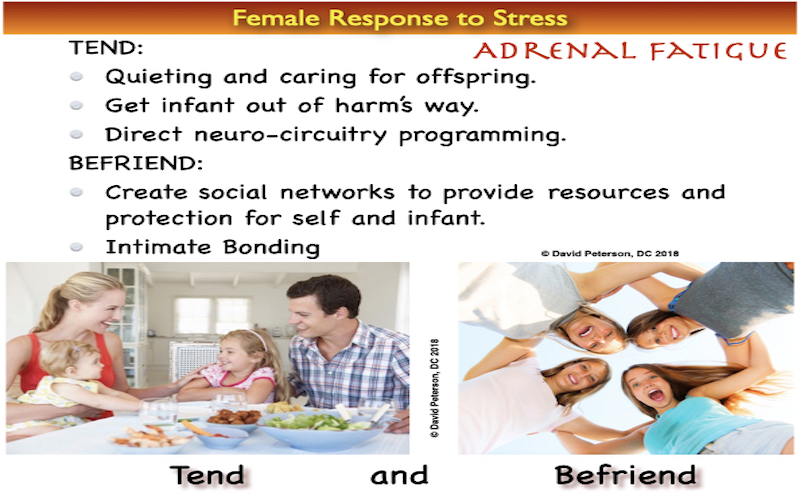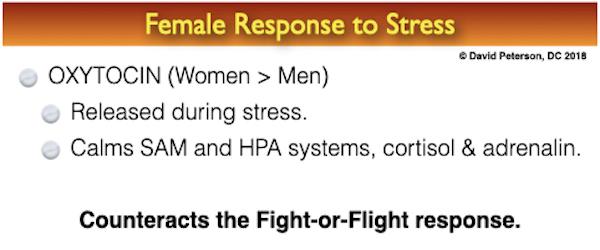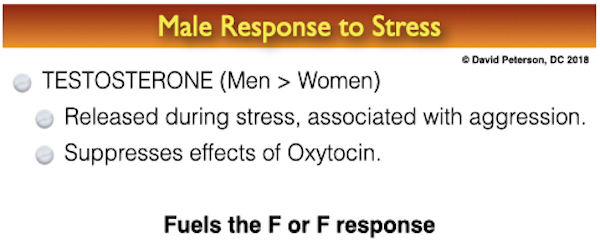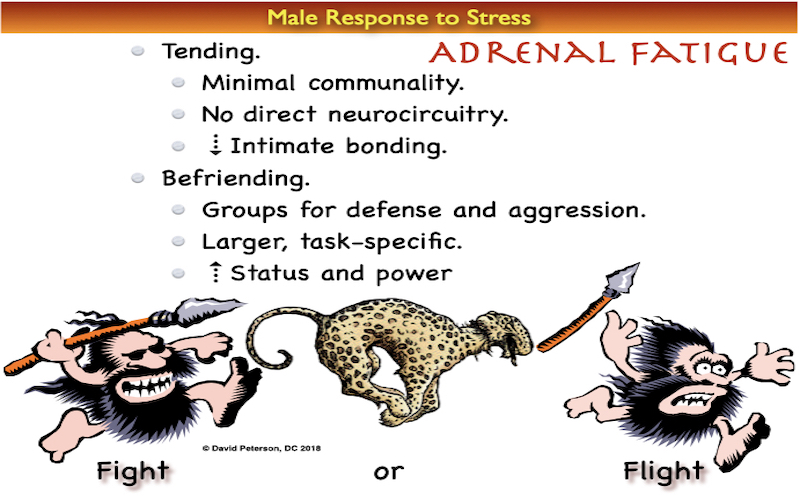When faced with danger, the classic “fight-or-flight” response has long been the go-to explanation for how humans react to stress. But what if this model doesn’t fully capture the experience of half the population? In 2000, Taylor et al. introduced a groundbreaking concept: the tend-and-befriend response, a stress reaction unique to females, rooted in evolutionary biology and driven by a cascade of hormones like oxytocin.1Taylor, S. E., Klein, L. C., Lewis, B. P., Gruenewald, T. L., Gurung, R. A. R, & Updegraff, J. A. (2000). Biobehavioral responses to stress in females: Tend-and-befriend, not fight-or-flight. Psychological Review, 107, 441-429. This response challenges the one-size-fits-all approach to stress and highlights the remarkable ways females ensure survival for themselves and their offspring. Let’s dive into the science and significance of this fascinating mechanism, as explored by Lauren A. McCarthy in her paper, Evolutionary and Biochemical Explanations for a Unique Female Stress Response: Tend-and-Befriend.2McCarthy, M. M. (1995). Estrogen modulation of oxytocin and its relation to behavior. In R. Ivell & J. Russell (Eds.), Oxytocin: Cellular and molecular approaches in medicine and research (pp. 235-242). New York: Plenum.

What are the symptoms of an Abnormal Tend-and-Befriend Response
An abnormal tend-and-befriend response, where women prioritize social connections and nurturing over other stress responses, can manifest as symptoms of stress, anxiety, or depression. This can include heightened irritability, difficulty sleeping, changes in appetite, and weakened immune function. In some cases, individuals may experience social withdrawal, difficulty concentrating, or even suicidal ideation.
Symptoms of Stress and Potential Overlap with Abnormal Tend-and-Befriend:
- Emotional:Irritability, anger, tearfulness, anxiety, worry, hopelessness, fear, difficulty making decisions.
- Cognitive:Racing thoughts, feeling overwhelmed, difficulty concentrating.
- Physical:Headaches, muscle tension, back pain, fatigue, changes in appetite (eating excessively or losing appetite), difficulty sleeping.
- Social:Withdrawing from family and friends, avoiding social situations, difficulty with daily activities.
- Behavioral:Not doing important things, such as work or paying bills, thinking about suicide.
Potential Consequences of an Overly Prominent Tend-and-Befriend Response:
- Burnout:Constant nurturing and social engagement can lead to exhaustion and depletion of resources, especially if boundaries are not maintained.
- Neglect of Self-Needs:Prioritizing others’ needs over one’s own can lead to neglecting physical and emotional well-being.
- Difficulty with Independence:A strong reliance on social support can make it challenging to navigate difficult situations independently.
- Exacerbation of Existing Mental Health Issues:The stress associated with social withdrawal and neglecting self-care can worsen pre-existing anxiety or depression.
Important Considerations:
- Individual Variation:Not all individuals experience stress responses in the same way, and some may naturally lean more towards tending and befriending.
- Context Matters:The appropriateness of a tend-and-befriend response can depend on the specific situation and the individual’s personal history and beliefs.
- Seeking Professional Help:If symptoms of stress, anxiety, or depression are persistent or severe, seeking professional help from a therapist or counselor is recommended.

Beyond Fight-or-Flight: A Female Perspective
The fight-or-flight response, coined by Walter Cannon in 1932,3Cannon, W. B. (1932). The wisdom of the body. New York: Norton. describes a surge of epinephrine and norepinephrine that prepares the body to confront or escape a threat. Historically, this model was studied primarily in males, with females making up just 17% of research participants until 1995. Why the imbalance? Researchers often cited fluctuating hormone levels during menstrual cycles as a complicating factor. But this male-centric lens missed something critical: females may have evolved a different strategy altogether.
Enter tend-and-befriend. Unlike the aggressive or evasive tactics of fight-or-flight, this response involves tending—nurturing and protecting offspring—and befriending—forming social alliances to boost survival odds.4Benton, D. (1992). Hormones and human aggression. In K. Bjorkqvist & P. Niemela (Eds.), Of mice and women: Aspects of female aggression (pp. 37-50). San Diego, CA: Academic. Evolutionarily, this makes sense. Females, often pregnant or caring for young, couldn’t always fight or flee effectively. A physical confrontation or hasty escape could endanger both mother and child. Instead, forming networks with other females offered protection, shared resources, and emotional support, increasing the chances of survival in a threatening world.
The Hormonal Symphony: Oxytocin Takes Center Stage
At the heart of tend-and-befriend lies oxytocin, often dubbed the “love hormone” for its role in bonding, labor, and lactation. While both sexes produce oxytocin, females have higher baseline levels, amplified by estrogen. When stress hits, oxytocin surges in females, promoting calmness, reducing fear, and fostering caregiving behaviors. This contrasts sharply with the male stress response, where testosterone and vasopressin fuel aggression or withdrawal—hallmarks of fight-or-flight.5Jezova, E., Skultetyova, I.,Tokarev, D. I., Bakos, P., & Vigas, M. (1995). Vasopressin and oxytocin in stress. In G. P. Chrousos, R. McCarty, K. Pacak, G. Cizza, E. Sternberg, P. W. Gold, & R. Kvetnansky (Eds), Stress: Basic mechanisms and clinical mechanisms and clinical implications (Vol. 771, pp. 192-203). New York: Annals of the New York Academy of Sciences. 6Ehrenkranz, J., Bliss, E., & Sheard, M. H. (1974). Plasma testosterone correlation with aggressive behavior and social dominance in man. Psychosomatic Medicine, 36, 469-475.
Studies illuminate oxytocin’s power. In animal research, oxytocin infusions triggered maternal behaviors in rats and sheep, with sheep responding almost instantly, likely due to their high parental investment in fewer offspring. In humans, oxytocin levels rise during relaxation (like a massage) and drop during sadness, stabilizing blood pressure and counteracting cortisol, the stress hormone tied to fight-or-flight. This biochemical cascade doesn’t just soothe—it encourages females to nurture their young and seek support from others, creating a protective network.

Contrast this with testosterone, which dominates the male stress response. Linked to aggression in both human and animal studies, testosterone spikes in males under stress, correlating with hostility and dominance.7Adams, D. (1992). Biology does not make men more aggressive than women. In K. Bjorkqvist & P. Niemela (Eds.), Of mice and women: Aspects of female aggression (pp. 17-26). San Diego, CA: Academic. While females can exhibit aggression—think of a mother defending her child—it’s typically reactive, not driven by the same testosterone-fueled pathway.8Bjorkqvist, K., & Niemela, P. (1992). New trends in the study of female aggression. In K. Bjorkqvist & P. Niemela (Eds.), Of mice and women: Aspects of female aggression (pp. 3-16). San Diego, CA: Academic. Even when females show higher testosterone levels (e.g., in violent offenders), their aggression differs from the male pattern, often leaning toward psychological rather than physical expressions.9Ehlers, C. L., Rickler, K. C., & Hovey, J. E. (1988). A possible relationship between plasma testosterone and aggressive behavior in a female outpatient population. In M. Girfis & L.G. Kiloh (Eds.), Limber epilepsy and the dyscontrol syndrome (pp. 183-194). New York: Elsevier.

Evolutionary Edge: Why Tend-and-Befriend Wins
The tend-and-befriend response isn’t just a quirk—it’s a survival strategy honed by evolution. Females who banded together were better equipped to fend off threats, whether from predators or resource scarcity. A group of females could deter a predator more effectively than a lone mother, and shared caregiving ensured offspring were protected even if one female was vulnerable. This social network also secured essentials like food and shelter, critical for survival in harsh environments.
Interestingly, this response may also shield females from threats closer to home. Studies show that women without strong female networks—such as immigrants isolated from community—are more vulnerable to abuse.10Bergman, B., & Brismar, B. (1994). Hormone levels and personality traits in abusive and suicidal male alcoholics. Alcoholism: Clinical and Experimental Research, 18, 311-316. Befriending creates a safety net, offering both practical and emotional support. Unlike male alliances, often formed for dominance or territorial control, female networks prioritize mutual care and protection, reflecting the tend-and-befriend ethos.
Not Just for Moms: A Broader Impact
While tend-and-befriend is closely tied to maternal instincts, its effects ripple beyond parenting. Adolescent girls, for instance, lean on support networks during stress, unlike boys who may opt for physical outlets.11Bird, G. W., & Harris, R. L. (1990). A comparison of role strain and coping strategies by gender and family structure among early adolescents. Journal of Early Adolescence, 10, 141-158. This pattern emerges post-puberty, when sex hormones like estrogen and oxytocin begin shaping behavior. Even in non-maternal contexts, females tend to seek connection under pressure, a trait that fosters resilience and community.12Uvnas-Moberg, K. (1997). Oxytocin linked antistress effects: The relaxation and growth response. Acta Psychologica Scandinavica, 640 (Suppl.), 38-42.
But is tend-and-befriend universal? Critics, like peer commentator Patricia J. Bergemann, argue it may not fit every woman. Personality, stress type, and hormone levels vary, suggesting a spectrum of responses rather than a one-size-fits-all model. Some women tackle stress solo, possibly due to lower oxytocin sensitivity or a preference for independence. Similarly, Caitlin M. Jones raises questions about attachment styles and personality traits like introversion, which could dampen the drive to befriend. These critiques highlight the need for further research to refine our understanding of this response.13Uvnas-Moberg, K. (1998). Oxytocin may mediate the benefits of positive social interaction and emotion. Psychoneuroendocrinology, 23, 819-835.
Addressing Misconceptions: It’s Not About Parenting
One point McCarthy clarifies in her author response is that tend-and-befriend isn’t a commentary on parenting prowess. Peer commentator Amanda K. Bruskin worried the theory implies men are biologically unfit for caregiving, but this misses the mark. Tend-and-befriend describes a stress response, not a parenting manual. Intriguingly, research shows men experience hormonal shifts during their partner’s pregnancy—lower testosterone, higher oxytocin—that promote paternal care.14Gubernick, D. J., Winslow, J. T., Jensen, P., Jeanotte, L., & Bowen, J. (1995). Oxytocin changes in males over the reproductive cycle in the monogamous, biparental California Mouse, Peromyscus californicus. Hormones and Behavior, 29, 59-73. 15Berg, S. J., & Wynne-Edwards, K. E. (2001). Changes in testosterone, cortisol, and estradiol levels in men becoming fathers. Mayo Clinic Proceedings, 76, 582-592. 16Baumeister, R. F., & Sommer, K. L. (1997). What do men want? Gender differences and two spheres of belongingness: Comment on Cross and Madson (1997). Psychological Bulletin, 122, 38-44. 17Adams, D. (1992). Biology does not make men more aggressive than women. In K. Bjorkqvist & P. Niemela (Eds.), Of mice and women: Aspects of female aggression (pp. 17-26). San Diego, CA: Academic. This suggests both sexes are wired for protection, just through different pathways.
Why It Matters Today
The discovery of tend-and-befriend flips the script on stress research, exposing the limits of the fight-or-flight model. It validates female experiences, long overlooked in science, and underscores the power of social bonds in navigating life’s challenges. In modern contexts—whether facing workplace stress, natural disasters, or personal crises—the instinct to connect and care remains a vital tool for resilience.
Yet, as Bergemann and Jones note, individual differences matter. Not every woman will tend-and-befriend, just as not every man will fight-or-flee. Hormones lay the foundation, but personality, culture, and context shape the outcome. Ongoing research, especially in diverse human populations, will help clarify these nuances.
Final Thoughts
The tend-and-befriend response is more than a scientific curiosity—it’s a testament to the strength of female biology and social networks. By nurturing offspring and forging alliances, females have carved out a unique evolutionary path to survival. Oxytocin’s calming embrace, amplified by estrogen, transforms stress into an opportunity for connection and care. As we continue to explore this response, we’re reminded that survival isn’t just about fighting or fleeing—it’s about building bridges and protecting those we love.
For those eager to learn more, check out Taylor et al.’s 2000 study or explore stress response research on platforms like grok.com. What’s your take—do you see tend-and-befriend in action in your life? Let’s keep the conversation going!
References
- 1Taylor, S. E., Klein, L. C., Lewis, B. P., Gruenewald, T. L., Gurung, R. A. R, & Updegraff, J. A. (2000). Biobehavioral responses to stress in females: Tend-and-befriend, not fight-or-flight. Psychological Review, 107, 441-429.
- 2McCarthy, M. M. (1995). Estrogen modulation of oxytocin and its relation to behavior. In R. Ivell & J. Russell (Eds.), Oxytocin: Cellular and molecular approaches in medicine and research (pp. 235-242). New York: Plenum.
- 3Cannon, W. B. (1932). The wisdom of the body. New York: Norton.
- 4Benton, D. (1992). Hormones and human aggression. In K. Bjorkqvist & P. Niemela (Eds.), Of mice and women: Aspects of female aggression (pp. 37-50). San Diego, CA: Academic.
- 5Jezova, E., Skultetyova, I.,Tokarev, D. I., Bakos, P., & Vigas, M. (1995). Vasopressin and oxytocin in stress. In G. P. Chrousos, R. McCarty, K. Pacak, G. Cizza, E. Sternberg, P. W. Gold, & R. Kvetnansky (Eds), Stress: Basic mechanisms and clinical mechanisms and clinical implications (Vol. 771, pp. 192-203). New York: Annals of the New York Academy of Sciences.
- 6Ehrenkranz, J., Bliss, E., & Sheard, M. H. (1974). Plasma testosterone correlation with aggressive behavior and social dominance in man. Psychosomatic Medicine, 36, 469-475.
- 7Adams, D. (1992). Biology does not make men more aggressive than women. In K. Bjorkqvist & P. Niemela (Eds.), Of mice and women: Aspects of female aggression (pp. 17-26). San Diego, CA: Academic.
- 8Bjorkqvist, K., & Niemela, P. (1992). New trends in the study of female aggression. In K. Bjorkqvist & P. Niemela (Eds.), Of mice and women: Aspects of female aggression (pp. 3-16). San Diego, CA: Academic.
- 9Ehlers, C. L., Rickler, K. C., & Hovey, J. E. (1988). A possible relationship between plasma testosterone and aggressive behavior in a female outpatient population. In M. Girfis & L.G. Kiloh (Eds.), Limber epilepsy and the dyscontrol syndrome (pp. 183-194). New York: Elsevier.
- 10Bergman, B., & Brismar, B. (1994). Hormone levels and personality traits in abusive and suicidal male alcoholics. Alcoholism: Clinical and Experimental Research, 18, 311-316.
- 11Bird, G. W., & Harris, R. L. (1990). A comparison of role strain and coping strategies by gender and family structure among early adolescents. Journal of Early Adolescence, 10, 141-158.
- 12Uvnas-Moberg, K. (1997). Oxytocin linked antistress effects: The relaxation and growth response. Acta Psychologica Scandinavica, 640 (Suppl.), 38-42.
- 13Uvnas-Moberg, K. (1998). Oxytocin may mediate the benefits of positive social interaction and emotion. Psychoneuroendocrinology, 23, 819-835.
- 14Gubernick, D. J., Winslow, J. T., Jensen, P., Jeanotte, L., & Bowen, J. (1995). Oxytocin changes in males over the reproductive cycle in the monogamous, biparental California Mouse, Peromyscus californicus. Hormones and Behavior, 29, 59-73.
- 15Berg, S. J., & Wynne-Edwards, K. E. (2001). Changes in testosterone, cortisol, and estradiol levels in men becoming fathers. Mayo Clinic Proceedings, 76, 582-592.
- 16Baumeister, R. F., & Sommer, K. L. (1997). What do men want? Gender differences and two spheres of belongingness: Comment on Cross and Madson (1997). Psychological Bulletin, 122, 38-44.
- 17Adams, D. (1992). Biology does not make men more aggressive than women. In K. Bjorkqvist & P. Niemela (Eds.), Of mice and women: Aspects of female aggression (pp. 17-26). San Diego, CA: Academic.